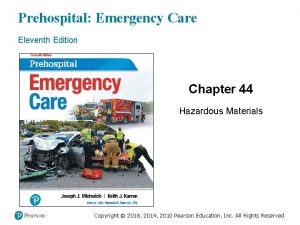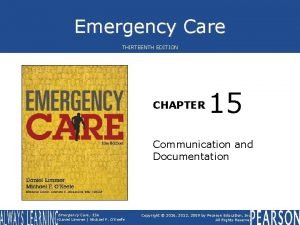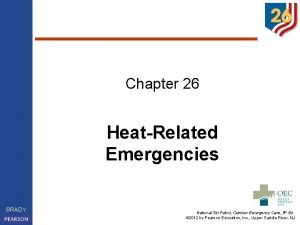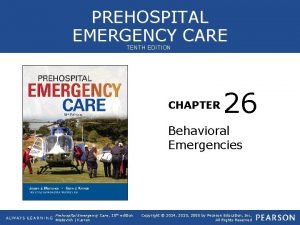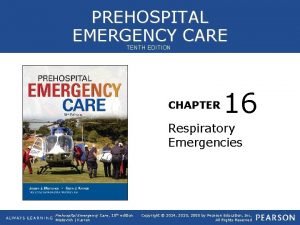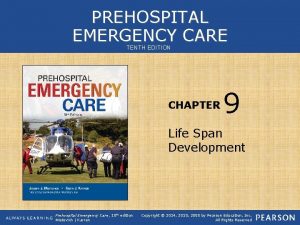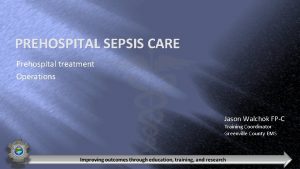PREHOSPITAL EMERGENCY CARE TENTH EDITION CHAPTER 14 Pharmacology












- Slides: 12

PREHOSPITAL EMERGENCY CARE TENTH EDITION CHAPTER 14 Pharmacology and Medication Administration Prehospital Emergency Care, 10 th edition Mistovich | Karren Copyright © 2014, 2010, 2008 by Pearson Education, Inc. All Rights Reserved

Table 14 -1 Names Common Generic and Trade Medication Prehospital Emergency Care, 10 th edition Mistovich | Karren Copyright © 2014, 2010, 2008 by Pearson Education, Inc. All Rights Reserved

Figure 14 -1 a The EMT may assist the patient with administration of nitroglycerin prescribed for chest pain. Two common forms are tablet and spray. Prehospital Emergency Care, 10 th edition Mistovich | Karren Copyright © 2014, 2010, 2008 by Pearson Education, Inc. All Rights Reserved

Figure 14 -1 b Aspirin, in pill form, may be administered for chest pain when a heart attack is suspected. Prehospital Emergency Care, 10 th edition Mistovich | Karren Copyright © 2014, 2010, 2008 by Pearson Education, Inc. All Rights Reserved

Figure 14 -2 a The epinephrine auto-injector may be prescribed for patients with a history of severe allergic or anaphylactic reaction. The Epi. Pen is a brand of epinephrine auto-injector. Prehospital Emergency Care, 10 th edition Mistovich | Karren Copyright © 2014, 2010, 2008 by Pearson Education, Inc. All Rights Reserved

Figure 14 -2 b The epinephrine auto-injector may be prescribed for patients with a history of severe allergic or anaphylactic reaction. The Twinject is a brand of epinephrine auto-injector. Prehospital Emergency Care, 10 th edition Mistovich | Karren Copyright © 2014, 2010, 2008 by Pearson Education, Inc. All Rights Reserved

Figure 14 -3 Oral glucose is a viscous gel used in acute diabetic emergencies. It is carried on the EMS unit. Prehospital Emergency Care, 10 th edition Mistovich | Karren Copyright © 2014, 2010, 2008 by Pearson Education, Inc. All Rights Reserved

Figure 14 -4 Activated charcoal is administered in suspension form and is carried on some EMS units. It may be used in poisoning and overdose emergencies. Prehospital Emergency Care, 10 th edition Mistovich | Karren Copyright © 2014, 2010, 2008 by Pearson Education, Inc. All Rights Reserved

Figure 14 -5 a A metered-dose inhaler or a metered-dose inhaler with a spacer may be prescribed for respiratory conditions. Prehospital Emergency Care, 10 th edition Mistovich | Karren Copyright © 2014, 2010, 2008 by Pearson Education, Inc. All Rights Reserved

Figure 14 -5 Nebulized medications may be administered by a small-volume nebulizer, through either a mouthpiece or a face mask. (© Carl Leet, YSU) Prehospital Emergency Care, 10 th edition Mistovich | Karren Copyright © 2014, 2010, 2008 by Pearson Education, Inc. All Rights Reserved

Figure 14 -6 The gas oxygen is considered a medication. It is the most commonly used medication in EMS and is carried on the EMS unit. Prehospital Emergency Care, 10 th edition Mistovich | Karren Copyright © 2014, 2010, 2008 by Pearson Education, Inc. All Rights Reserved

Figure 14 -7 You must obtain an order from medical direction to administer medication or to assist the patient with administration of medication. Be sure the prescription is for the patient you are treating, and check the expiration date of the medication. Prehospital Emergency Care, 10 th edition Mistovich | Karren Copyright © 2014, 2010, 2008 by Pearson Education, Inc. All Rights Reserved
 Prehospital emergency care 11th edition
Prehospital emergency care 11th edition The standards of prehospital emergency care
The standards of prehospital emergency care Pre-hospital communication
Pre-hospital communication Prehospital emergency care 11th edition study guide
Prehospital emergency care 11th edition study guide Prehospital emergency care 11th edition
Prehospital emergency care 11th edition Prehospital emergency care 11th edition
Prehospital emergency care 11th edition Emergency care 13th edition
Emergency care 13th edition Outdoor emergency care 6th edition
Outdoor emergency care 6th edition Campbell biology tenth edition
Campbell biology tenth edition Campbell biology tenth edition
Campbell biology tenth edition Campbell biology tenth edition
Campbell biology tenth edition Elementary statistics tenth edition
Elementary statistics tenth edition Digital fundamentals 10th edition
Digital fundamentals 10th edition





